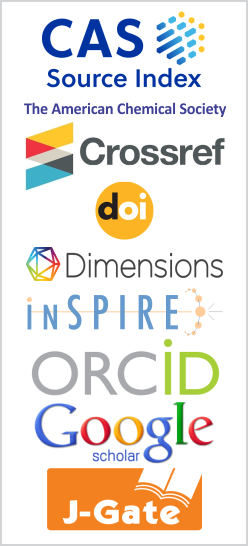Ionization of the \(1S\) and \(nS\) States of the Atomic Hydrogen by Positron and Electron Impacts
DOI:
https://doi.org/10.26713/jamcnp.v12i1.3436Abstract
The ionizations of the \(1S\) and \(nS\) states of the atomic hydrogen have been carried out using the hybrid theory, which is variationally correct and has been obtained by modifying the method of polarized orbitals. Earlier, we calculated cross sections of exciting the higher states from the ground state, and cross sections of photoabsorption. Now, we apply the same approach to the ionization of states. The distortion of the orbit is considered due to the incident positron or electron. The distortion takes place whether the incident particle is outside or inside the orbit. Temkin considered distortion of the target electron only when the incident particle is outside the orbit of the target. However, there is no simple way to consider distortion of \(nS\) states of atomic hydrogen. The cross sections are calculated by considering the distortion in the initial state as well as in the final state only in the \(1S\) state and are compared with the previous calculations and the experimental results. The present cross sections have a maximum at an energy which is the same as the incident energy in the experimental results.
Downloads
References
P. A. M. Dirac, Theory of electrons and protons, Proceedings of the Royal Society A 126 (1930), 360, DOI: 10.1098/rspa.1930.0013.
M. Abramowitz and I. A. Stegun, Handbook of Mathematical Functions, National Bureau of Standard, p. 538 (1964), URL: https://personal.math.ubc.ca/~cbm/aands/abramowitz_and_stegun.pdf.
C. D. Anderson, The positive electron, Physical Review Journals Archive 43 (1933), 491, DOI: 10.1103/PhysRev.43.491.
A. K. Bhatia, Hybrid theory of electron-hydrogen elastic scattering, Physical Review A 75 (2007), 032713, DOI: 10.1103/PhysRevA.75.032713.
A. K. Bhatia, Scattering and its applications to various atomic processes: Elastic scattering, resonances, photoabsorption, rydberg states, and opacity of the atmosphere of the sun and stellar objects, Atoms 8 (2020), 988, DOI: 10.3390/atoms8040078.
R. J. Drachman and A. Temkin, Polarized Orbital Approximations, in: Case Studies in Atomic Collision Physics II, E. W. McDaniel and hl. R. C. McDowell (editors), pp. 401 – 481 (1972).
A. R. Edmonds, Angular Momentum in Quantum Mechanics, Princeton University Press, p. 81 (1957).
A. S. Ghosh, P. S. Majumdar and M. Basu, Positron-impact ionization of hydrogen atoms, Canadian Journal of Physics 63 (1985), 621, DOI: 10.1139/p85-095.
H. Klar, Threshold ionization of atoms by positrons, Journal of Physics B: Atomic and Molecular Physics 14 (1961), 4165, DOI: 10.1088/0022-3700/14/21/027.
A. P. Mills(Jr.), Observation of the positronium negative ion, Physical Review Letters 46 (1981), 717, DOI: 10.1103/PhysRevLett.46.717.
K. Omidvar, 2s and 2p electron impact excitation in atomic hydrogen, Physical Review Journals Archive 133 (1964), A970, DOI: 10.1103/PhysRev.133.A970.
S. Sazonov, E. Churazov, R. Sunyaev and M. Revnivbsev, Annihilation of positrons in the Galaxy, Experimental Astronomy 20 (2005), 15, DOI: 10.1007/s10686-006-9039-0.
J. Shertzer and A. Temkin, Direct calculation of the scattering amplitude without partial wave analysis. III. Inclusion of correlation effects, Physical Review A 74 (2006), 052701, DOI: 10.1103/PhysRevA.74.052701.
G. Spicher, B. Olson, W. Raith, G. Sinapius and W. Sperber, Ionization of atomic hydrogen by positron impact, Physical Review Letters 64 (1990), 1019, DOI: 10.1103/PhysRevLett.64.1019.
A. Temkin, A note on the scattering of electrons from atomic hydrogen, Physical Review Journals Archive 116 (1959), 358, DOI: 10.1103/PhysRev.116.358.
A. Temkin, A precis of threshold laws for positrons vs. electrons impact ionization of atoms, Atoms 8(2) (2020), 11, DOI: 10.3390/atoms8020011.
G. H. Wannier, The threshold law for single ionization of atoms or ions by electron impact, Physical Review Journals Archive 90 (1953), 817, DOI: 10.1103/PhysRev.90.817.
Downloads
Published
How to Cite
Issue
Section
License
Authors who publish with this journal agree to the following terms:- Authors retain copyright and grant the journal right of first publication with the work simultaneously licensed under a CCAL that allows others to share the work with an acknowledgement of the work's authorship and initial publication in this journal.
- Authors are able to enter into separate, additional contractual arrangements for the non-exclusive distribution of the journal's published version of the work (e.g., post it to an institutional repository or publish it in a book), with an acknowledgement of its initial publication in this journal.
- Authors are permitted and encouraged to post their work online (e.g., in institutional repositories or on their website) prior to and during the submission process, as it can lead to productive exchanges, as well as earlier and greater citation of published work.




